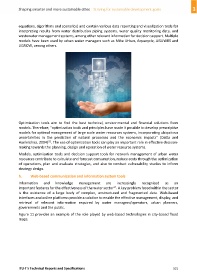Page 531 - Shaping smarter and more sustainable cities - Striving for sustainable development goals
P. 531
equations, algorithms and scenarios) and contain various data reporting and visualization tools for
interpreting results from water distribution piping systems, water quality monitoring data, and
wastewater management systems, among other relevant information for decision support. Multiple
models have been used by urban water managers such as Mike Urban, Aquacycle, AISUWRS and
UGROW, among others.
Optimization tools aim to find the best technical, environmental and financial solutions from
models. Therefore, "optimization tools and principles have made it possible to develop prescriptive
models for optimal management of large scale water resources systems, incorporating ubiquitous
uncertainties in the prediction of natural processes and the economic impacts" (Datta and
31
Harikrishna, 2004) . The use of optimization tools can play an important role in effective decision‐
making towards the planning, design and operation of water resource systems.
Models, optimization tools and decision support tools for network management of urban water
resources contribute to calculate and forecast consumption, reduce costs through the optimization
of operations, plan and evaluate strategies, and also to conduct vulnerability studies to inform
strategy design.
h. Web‐based communication and information system tools
Information and knowledge management are increasingly recognized as an
32
important features for the effectiveness of the water sector . A key problem faced within the sector
is the existence of a large body of complex, unstructured and fragmented data. Web‐based
interfaces and online platforms provide a solution to enable the effective management, display, and
retrieval of relevant information required by water managers/operators, urban planners,
governments and the public.
Figure 11 provides an example of the role played by web‐based technologies in city‐based flood
maps.
ITU‐T's Technical Reports and Specifications 521

